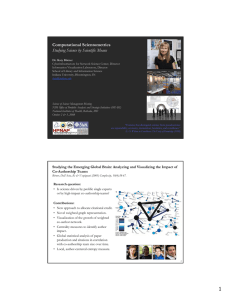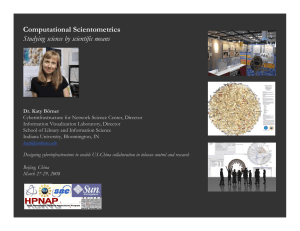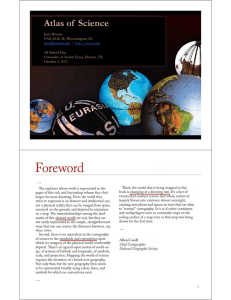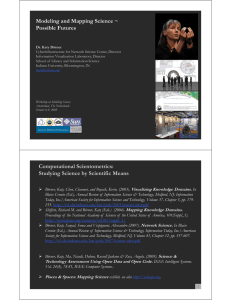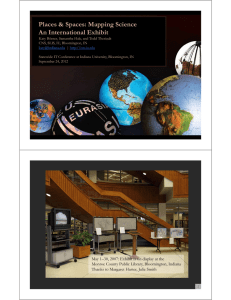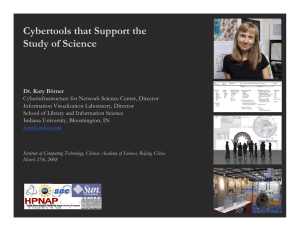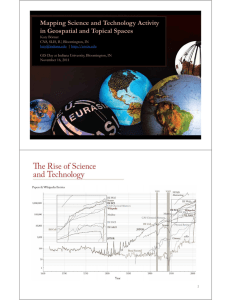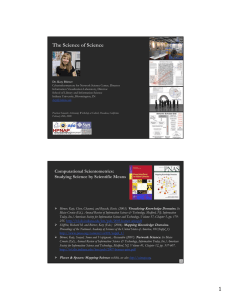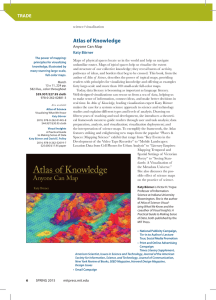User Friendly Cyberinfrastructures
advertisement
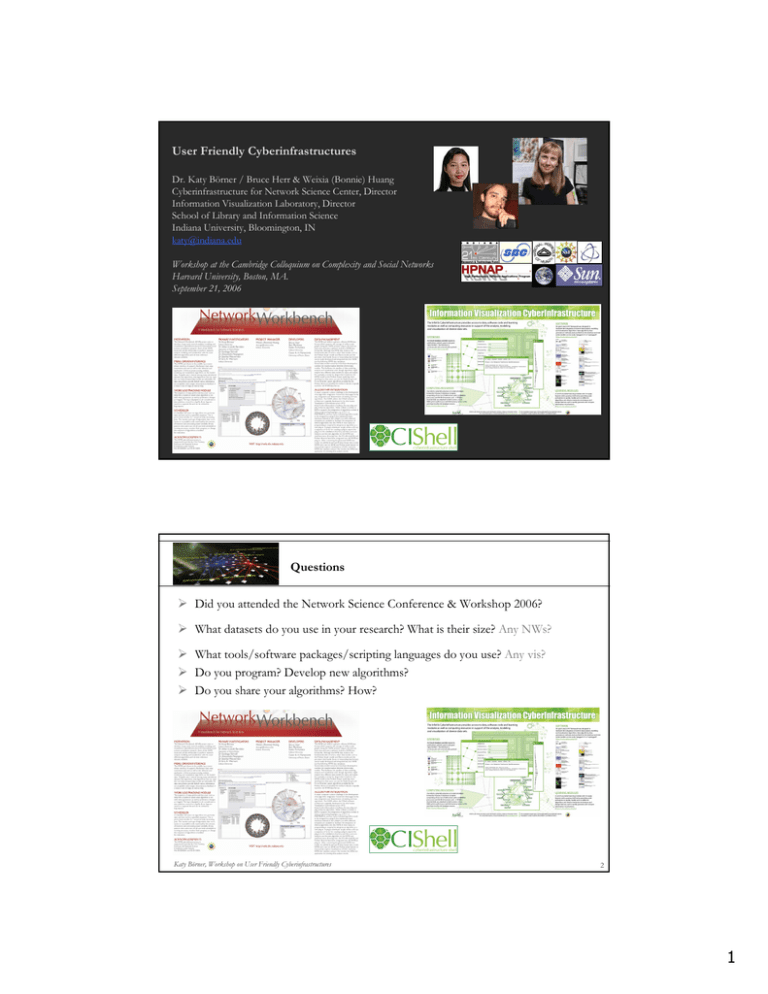
User Friendly Cyberinfrastructures Dr. Katy Börner / Bruce Herr & Weixia (Bonnie) Huang Cyberinfrastructure for Network Science Center, Director Information Visualization Laboratory, Director School of Library and Information Science Indiana University, Bloomington, IN katy@indiana.edu Workshop at the Cambridge Colloquium on Complexity and Social Networks Harvard University, Boston, MA. September 21, 2006 Questions Did you attended the Network Science Conference & Workshop 2006? What datasets do you use in your research? What is their size? Any NWs? What tools/software packages/scripting languages do you use? Any vis? Do you program? Develop new algorithms? Do you share your algorithms? How? Katy Börner, Workshop on User Friendly Cyberinfrastructures 2 1 This Talk has Three Parts: 1. Why Develop CI in a InfoVis Lab / NetSci Center? 2. Cyberinfrastructure Shell (CIShell) Framework 3. Utilizing CIShell to Serve Different Communities - Information Visualization CI - Network Workbench 3 This Talk has Three Parts: 1. Why Develop CI in a InfoVis Lab / NetSci Center? 2. Cyberinfrastructure Shell (CIShell) Framework 3. Utilizing CIShell to Serve Different Communities - Information Visualization CI - Network Workbench 4 2 Mapping the Evolution of Co-Authorship Networks in Information Visualization, 1988 - 2004 Ke, Visvanath & Börner, (2004) Won 1st price at the IEEE InfoVis Contest. Katy Börner, Workshop on User Friendly Cyberinfrastructures 5 Katy Börner, Workshop on User Friendly Cyberinfrastructures 6 3 ‘Places & Spaces: Mapping Science’ Science’ Exhibit http://scimaps.org/exhibit Illuminate Diagram Display 7 Katy Börner, Workshop on User Friendly Cyberinfrastructures 8 4 Example: Mapping Scientific Disciplines First Analysis & Visualization Layout Optimization List of Documents Term-Document Matrix Generator Threshold Application Term-Document Matrix Reduced Network in Pajek format Threshold Application Network Layout Highly frequent terms Co-Occurrence Similarity Calculation Pathfinder Network Scaling Similarity Matrix Reduced Network in Pajek format Converter Network Layout Network in Pajek Format Network Layout Katy Börner, Workshop on User Friendly Cyberinfrastructures 9 This Talk has Three Parts: 1. Why Develop CI in a InfoVis Lab / NetSci Center? 2. Cyberinfrastructure Shell (CIShell) Framework 3. Utilizing CIShell to Serve Different Communities - Information Visualization CI - Network Workbench 10 5 Why Do we Need Cyberinfrastructures? Problem There are too many and too complex datasets that need to be correlated and understood to arrive at the best possible decisions. There are too many different data formats, different algorithms, different implementations of the same algorithm, different programming languages, different research purposes (modeling, analysis, visualization), different communities and practices. The analysis, modeling, and visualization of large datasets requires powerful computing infrastructures. Managing 1000+ of different data sets and 100+ of different algorithms requires a means to quickly select the best dataset(s)/algorithm(s). Needed is a socio-technical cyberinfrastructure that supports Easy access to datasets and algorithms, computer resources, their descriptions, and associated learning modules and access to expertise. Katy Börner, Workshop on User Friendly Cyberinfrastructures 11 Cyberinfrastructure Shell (CIShell) http://cishell.org CIShell is an ‘empty shell’ that supports Easy integration of new datasets and algorithms by algorithm developers and Easy usage of algorithms by algorithm users. Its plug-and-play architecture supports the integration and utilization of diverse Datasets, e.g., stored in files, databases, steaming data. Algorithms, e.g., data processing, analysis, modeling, visualization. Interfaces, e.g., remote services, scripting engines, peer-to-peer clients. Services, e.g., workflow support, scheduler. Hence, it can be used for custom UI/Toolkit development. Katy Börner, Workshop on User Friendly Cyberinfrastructures 12 6 CIShell – Technical Details CIShell is built upon the Open Services Gateway Initiative (OSGi) Framework. OSGi (http://www.osgi.org) is A standardized, component oriented, computing environment for networked services. Successfully used in the industry from high-end servers to embedded mobile devices since 7 years. Alliance members include IBM (Eclipse), Sun, Intel, Oracle, Motorola, NEC and many others. Widely adopted in open source realm, especially since Eclipse 3.0 that uses OSGi R4 for its plugin model. Advantages of Using OSGi Any CIShell algorithm is a service that can be used in any OSGi-framework based system. Using OSGi, running CIShells/tools can connected via RPC/RMI supporting peer-topeer sharing of data, algorithms, and computing power. Ideally, CIShell becomes a standard for creating OSGi Services for algorithms. Developed Tools/CI, e.g., IVC & NWB, provide a reference GUI for underlying services. Katy Börner, Workshop on User Friendly Cyberinfrastructures 13 Serve Algorithms Developers & Users Users Developers CIShell Wizards CIShell IVC Interface NWB Interface Katy Börner, Workshop on User Friendly Cyberinfrastructures 14 7 Deployment Data-Algorithm Repositories Peer-to-Peer Stand Alone Server-Client CIShell applications can be deployed as distributed data and algorithm repositories, stand alone applications, peer-to-peer architectures, and server-client architectures. Katy Börner, Workshop on User Friendly Cyberinfrastructures 15 This Talk has Three Parts: 1. Why Develop CI in a InfoVis Lab / NetSci Center? 2. Cyberinfrastructure Shell (CIShell) Framework 3. Utilizing CIShell to Serve Different Communities - Information Visualization CI - Network Workbench 16 8 CAREER: Visualizing Knowledge Domains. NSF IIS-0238261 award (Katy Börner, $451,000) Sept. 03-Aug. 08. http://iv.slis.indiana.edu/ SEI: Network Workbench: A Large-Scale Network Analysis, Modeling and Visualization Toolkit for Biomedical, Social Science and Physics Research. NSF IIS-0513650 award (Katy Börner, Albert-Laszlo Barabasi, Santiago Schnell, Alessandro Vespignani & Stanley Wasserman, Eric Wernert (Senior Personnel), $1,120,926) Sept. 05 - Aug. 08. http://nwb.slis.indiana.edu 17 CIShell in Support of IV and NWB CIs & Tools InfoVis CI NWB: Tool Data Katy Börner, Workshop on User Friendly Cyberinfrastructures NWB: Science Map CIShell 18 9 InfoVis Cyberinfrastructure http://iv.slis.indiana.edu Katy Börner, Workshop on User Friendly Cyberinfrastructures 19 IVC Database (http://iv.slis.indiana.edu/db) Katy Börner, Workshop on User Friendly Cyberinfrastructures 20 10 Katy Börner, Workshop on User Friendly Cyberinfrastructures 21 Katy Börner, Workshop on User Friendly Cyberinfrastructures 22 11 Katy Börner, Workshop on User Friendly Cyberinfrastructures 23 Time Series Analysis Learning Module http://iv.slis.indiana.edu/l m/lm-time-series.html Katy Börner, Workshop on User Friendly Cyberinfrastructures 24 12 Visualizing Tree Data Learning Module http://iv.slis.indiana.ed u/lm/lm-trees.html Katy Börner, Workshop on User Friendly Cyberinfrastructures 25 This Talk has Three Parts: 1. Why Develop CI in a InfoVis Lab / NetSci Center? 2. Cyberinfrastructure Shell (CIShell) Framework 3. Utilizing CIShell to Serve Different Communities - Information Visualization CI - Network Workbench 26 13 Network Workbench Investigators: Katy Börner, Albert-Laszlo Barabasi, Santiago Schnell, Alessandro Vespignani & Stanley Wasserman, Eric Wernert Software Team: Team Lead: Weixia (Bonnie) Huang Software Developers: Bruce Herr & Ben Markines Algorithm Developers: Santo Fortunato & Cesar Hidalgo Goal: Develop a large-scale network analysis, modeling and visualization toolkit for biomedical, social science and physics research. $1,120,926 NSF IIS-0513650 award. Sept. 2005 - Aug. 2008 http://nwb.slis.indiana.edu Amount: Duration: Website: Katy Börner, Workshop on User Friendly Cyberinfrastructures 27 28 14 NWB Tool: Interface Elements Load Data Select Preferences List of Data Models Console Visualize Data Scheduler Open Text Files Katy Börner, Workshop on User Friendly Cyberinfrastructures 29 List of Algorithms (partially implemented) Modeling Random Network Model Random Preferential Attachment Algorithms Barabasi-Albert Model Dorogovtsev-Mendes-Samukhin Fitness Vertices/edges deletion Copying strategy Finite vertex capacity TARL Rewiring algorithms Rewiring based on degree distribution Watts Strogatz Small World Model Peer-to-Peer Models Structured CAN Model Chord Model Unstructured PRU Model Hypergrid Model Katy Börner, Workshop on User Friendly Cyberinfrastructures Measurement Edge/Node level node degree BC value of nodes/edges Max flow edge Hub/Authority value for nodes Distribution of node distances (Hop plot) What other algorithms do you use? Local (directed and weighted versions) Clustering Coefficient (Watts Strogatz) Clustering Coefficient (Newman) k-Core Count Distributions (Plot and gamma, and R^2) Degree Distributions (in, out, total) (Directed/Total Degree Distribution) Degree Correlations (in-out, out-out, out-in, in-in, total-total) Clustering Coefficient over k Coherence for weighted graphs Distribution of weights Probability of degree distribution Global Density Square of Adjacency Matrix Giant Component Strongly Connected Component Betweenness Centrality Diameter Shortest Path = Geodesic Distance Average Path Length Motif Identification Page Rank Closeness centrality Reach centrality Eigenvector centrality Minimum Spanning Tree 30 15 List of Algorithms (partially implemented) Basic Processes on Networks Search k Random-Walk Search Depth First Search p-rand Breadth-First Search P2P CAN Search Chord Search Epidemics Spreading SIR SIS Graph Matching Simple Match Similarity Flooding ABSURDIST Clustering Based on Attributes Hierarchical Clustering Single Link Complete Link Average Link Ward's Algorithm Based on Network Structure Newman Girvan Clauset-Newman-Moore Newman Cecconi-Parisi Simulated annealing of modularity Caldarelli Weak Component Clustering vanDongen (random walk) Cfinder (Clique percolation method) Reichardt, Bornholdt (q-potts model) Visualization Distribution Scatterplot Histogram Geospatial Circle layout Grid-based Dendrogram Treemap Hyperbolic tree Radial Tree Sparse Matrix Visualization Kamada-Kawaii Fruchterman-Rheingold Orthogonal Layout k-core visualization What other algorithms do you use? Katy Börner, Workshop on User Friendly Cyberinfrastructures 31 Download Download the IVC from http://sourceforge.net/projects/ivc Click Download the ivc.1.0.4.full-installer.jar (with plugins). Install. Run. Enjoy. Note: If you have a Mac and the most recent JVM installed then you can download the empty IVC shell without plugins and get super old plugins from the update site at http://iv.slis.indiana.edu/ivc/update. Or you wait for the new release that will be available on October 2nd, 2006. Katy Börner, Workshop on User Friendly Cyberinfrastructures 32 16 References Bruce Herr, Weixia Huang, Shashikant Penumarthy, Katy Börner. Designing Highly Flexible and Usable Cyberinfrastructures for Convergence. Submitted to William S. Bainbridge (Ed.) Progress in Convergence. Annals of the New York Academy of Sciences. http://ella.slis.indiana.edu/~katy/paper/06-cishell.pdf Börner, Katy, Sanyal, Soma and Vespignani, Alessandro. Network Science: A Theoretical and Practical Framework. (in press) In Blaise Cronin (Ed.), Annual Review of Information Science & Technology, Volume 41, Medford, NJ: Information Today, Inc./American Society for Information Science and Technology. https://ivl.slis.indiana.edu/publications/borner2006-netsci.pdf See also publications linked from Network Workbench web site at http://nwb.slis.indiana.edu/ For further information please contact: Weixia (Bonnie) Huang, NWB Software Team Lead, Indiana University, huangb@indiana.edu Bruce Herr, CIShell Architect, Indiana University, bherr@indiana.edu Katy Börner, Workshop on User Friendly Cyberinfrastructures 33 17
